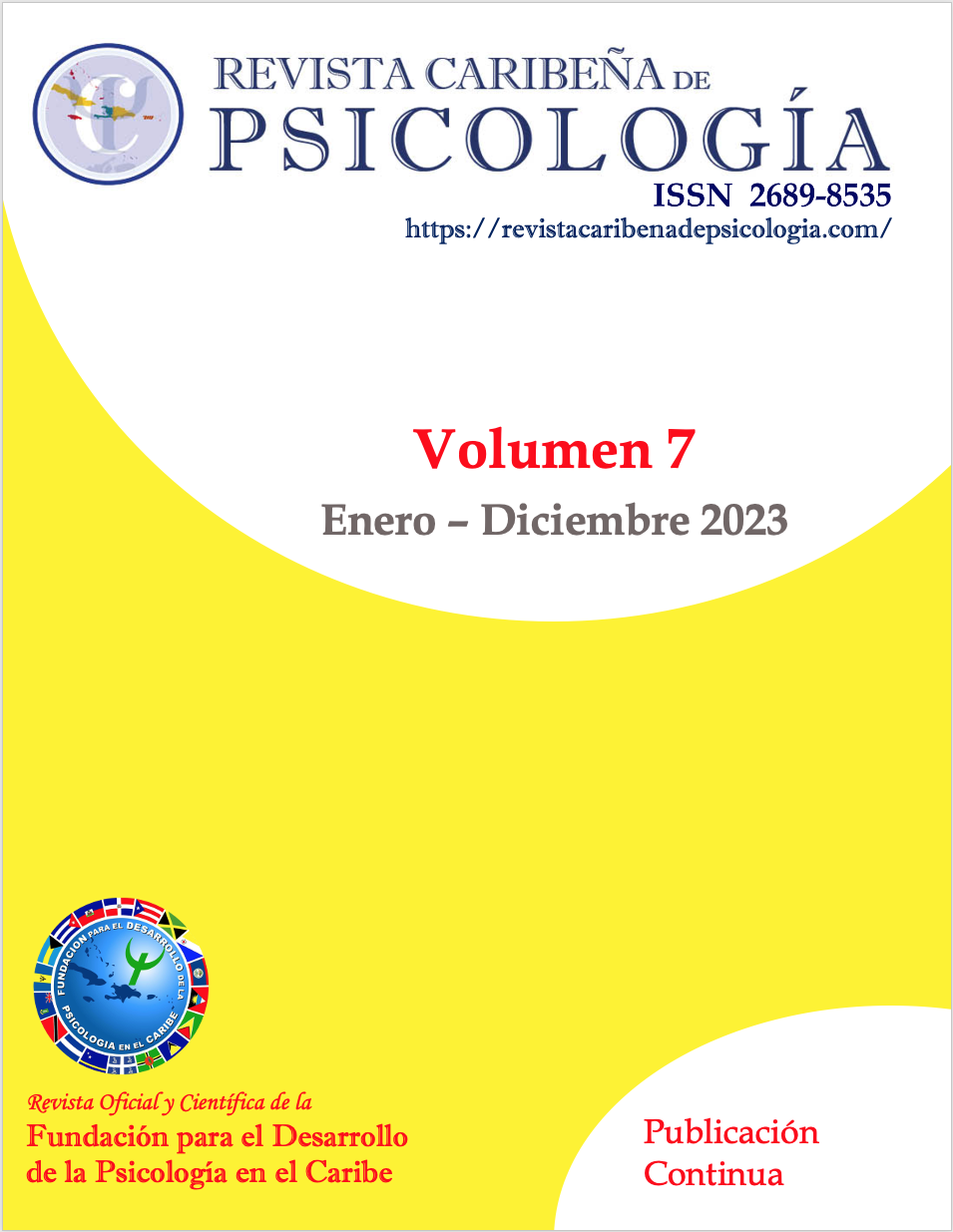Trauma en la Niñez y Síntomas Disociativos: El Rol Mediador del Apego Inseguro-Desorganizado
DOI:
https://doi.org/10.37226/rcp.v7i1.7217Palabras clave:
apego desorganizado, rol mediador, síntomas disociativos, trauma en la niñezResumen
El apego inseguro-desorganizado ha sido considerado como la primera instancia de un proceso mental disociativo en el desarrollo de la personalidad donde existe evidencia de la conexión entre la desorganización infantil y disociación posterior en la adultez. Este estudio tuvo como objetivo investigar si el apego inseguro desorganizado media la relación entre las experiencias de trauma en la niñez y los síntomas disociativos en la adultez. La muestra estuvo compuesta por 109 personas adultas entre las edades de 21 a 55 donde la mayoría fueron personas auto identificadas como mujeres (75.23%, n = 82) y que se encontraban en una relación de pareja (85.32%, n = 93). Los datos fueron recolectados a través del Cuestionario de Trauma en la niñez-Versión corta, la Escala de Apego Desorganizado en adultos y la Escala de Experiencias Disociativas. Se puso a prueba el modelo propuesto con análisis de sendero de mediación con ecuaciones estructurales. Se realizaron también análisis de correlación Producto Momento de Pearson. Los resultados obtenidos indican que el apego desorganizado media la relación entre el maltrato en la niñez y los síntomas disociativos en la muestra bajo estudio en carácter exploratorio.
Citas
Ainsworth, M. D. S., Blehar, M. C., Waters, E., & Wall, S. (1978). Patterns of attachment: A psychological study of the strange situa-tion. Erlbaum.
American Psychiatric Association. (2013). Diagnostic and Statistical Manual of Mental Disorders. In Diagnostic and Statistical Manual of Mental Disorders, (5th edition). American Psychiatric Asso-ciation. https://doi.org/10.1176/appi.books.9780890425596
Bernstein, D., Fink, L., Handelsman, L., Foote, J., Lovejoy, M., Wenzel, K., Sapareto, E., & Ruggiero, J. (1994). Initial reliability and validity of a new retrospectiva measure of child abuse and neglect. American Journal of Psychiatry, 151(8), 1132–1136. https://doi.org/10.1176/ajp.151.8.1132
Bernstein, D. P., Stein, J. A., Newcomb, M. D., Walker, E., Pogge, D., Ahluvalia, T., Stokes, J., Handelsman, L., Medrano, M., Desmond, D., & Zule, W. (2003). Development and validation of a brief screening version of the Childhood Trauma Ques-tionnaire. Child Abuse & Neglect, 27(2), 169–190. https://doi.org/10.1016/S0145-2134(02)00541-0
Bernstein, E., & Putnam, F. (1986). Development, Reliability, and Validity of a Dissociation Scale. Journal of Nervous and Mental Disease, 174(12), 727–735. https://doi.org/10.1097/00005053-199504000-00008
Browne, M.W. and Cudeck, R. (1992) Alternative Ways of Asses-sing Model Fit. Sociological Methods and Research, 21, 230-258. https://doi.org/10.1177/0049124192021002005
Carlson, E. A. (1998). A Prospective Longitudinal Study of At-tachment Disorganization/Disorientation. Child Development, 69(4), 1107–1128. https://doi.org/10.1111/j.1467-8624.1998.tb06163.x
Carlson, E. A., Egeland, B., & Sroufe, L. A. (2009). A prospective investigation of the development of borderline personality symptoms. Development and Psychopathology, 21(4), 1311–1334. https://doi.org/10.1017/S0954579409990174
Cassidy, J., & Mohr, J. (2001). Unsolvable Fear, Trauma, and Psychopathology: Theory, Research, and Clinical Considera-tions Related to Disorganized Attachment Across the Life Span. Clinical Psychology: Science and Practice, 8(3), 275–298. https://doi.org/10.1093/clipsy/8.3.275
Chavez, L. M., & Canino, G. (2005, April). Toolkit on Translating and Adapting Instruments. The Evaluation Center at Human Services Research Institute.
Cheung, G. W., & Lau, R. S. (2008). Testing mediation and suppression effects of latent variables: Bootstrapping with structural equation models. Organizational Research Methods, 11(2), 296–325. https://doi.org/10.1177/1094428107300343
Creswell, J. W. (2018). The selection of a research approach. In J. D. Creswell (Ed.), Research Design: Qualitative, Quantitativa and Mixed Methods Approach (Fifth, pp. 49–50). essay, SAGE.
De Bellis, M. (2001). Developmental traumatology: the psychobio-logical development of maltreated children and its implica-tions for research, treatment, and policy. Development and Psychopathology, 13(3), 539–564. https://doi.org/10.1017/s0954579401003078
Dell, P. F., & O’Neil, J. A. (2011). Dissociation and the dissociative disorders: DSM-V and beyond. In Dissociation and the Dissocia-tive Disorders: DSM-V and Beyond (pp. 1–864). Routledge. https://doi.org/10.4324/9780203893920
Dutra, L., Bureau, J.-F., Holmes, B., Lyubchik, A., & Lyons-Ruth, K. (2009). Quality of Early Care and Childhood Trauma. The Journal of Nervous and Mental Disease, 197(6), 383–390. https://doi.org/10.1097/NMD.0b013e3181a653b7
Francia-Martínez, M., de Torres, I. R., Alvarado, C. S., Martínez-Taboas, A., & Sayers, S. (2003). Dissociation, depression and trauma in psychiatric inpatients in Puerto Rico. Journal of Trauma & Dissociation, 4(4), 47–61. https://doi.org/10.1300/j229v04n04_04
Granqvist, P., Sroufe, L. A., Dozier, M., Hesse, E., Steele, M., Van Ijzendoorn, M., Solomon, J., Schuengel, C., Fearon, P., Baker-mans-Kranenburg, M., Steele, H., Cassidy, J., Carlson, E., Ma-digan, S., Jacobvitz, D., Foster, S., Behrens, K., Rifkin-Graboi, A., Gribneau, N., … Duschinsky, R. (2017). Disorganized at-tachment in infancy: A review of the phenomenon and its implications for clinicians and policy-makers. Attachment & Human Development, 19(6), 534–558. https://doi.org/10.1080/14616734.2017.1354040
Hernandez, A., Gallardo-Pujol, D., Pereda, N., Arntz, A., Berns-tein, D. P., Gaviria, A. M., Labad, A., Valero, J., & Gutiérrez-Zotes, J. A. (2013). Initial Validation of the Spanish Childhood Trauma Questionnaire-Short Form. Journal of Interpersonal Vio-lence, 28(7), 1498–1518. https://doi.org/10.1177/0886260512468240
Hesse, E., & Van Ijzendoorn, M. H. (1999). Propensities towards absorption are related to lapses in the monitoring of reasoning or discourse during the Adult Attachment Interview. At-tachment & Human Development, 1(1), 67–91. https://doi.org/10.1080/14616739900134031
Hollidge, C. F., & Hollidge, E. O. (2016). Seeking Security in the Face of Fear: The Disorganized Dilemma. Psychoanalytic Social Work, 23(2), 130–144. https://doi.org/10.1080/15228878.2016.1171789
Holmes, J. (2004). Disorganized attachment and borderline perso-nality disorder: A clinical perspective. Attachment & Human Development, 6(2), 181–190. https://doi.org/10.1080/14616730410001688202
Kobak, R., Zajac, K., & Madsen, S. D. (2016). Attachment Disrup-tions, Reparative Processes, and Psychopathology: Theoretical and Clinical Implications. In Jude Cassidy & Philip R. Shaver (Eds.). Handbook of Attachment, Third Edition: Theory, Re-search, and Clinical Applications, 3, 25–39.
Kong, S. S., Kang, D. R., Oh, M. J., & Kim, N. H. (2018). Attach-ment insecurity as a mediator of the relationship between childhood trauma and adult dissociation. Journal of Trauma & Dissociation, 19(2), 214–231. https://doi.org/10.1080/15299732.2017.1329772
Liotti, G. (2004). Trauma, dissociation, and disorganized attach-ment: Three strands of a single braid. Psychotherapy: Theory, Research, Practice, Training, 41(4), 472–486. https://doi.org/10.1037/0033-3204.41.4.472
Lyons-Ruth, K., Dutra, L., Schuder, M. R., & Bianchi, I. (2006). From Infant Attachment Disorganization to Adult Dissocia-tion: Relational Adaptations or Traumatic Experiences? Psychiatric Clinics of North America, 29(1), 63–86. https://doi.org/10.1016/j.psc.2005.10.011
Main, M., & Solomon, J. (1986). Discovery of an insecure-disorganized/disoriented attachment pattern. In T. B. Brazel-ton & M. W. Yogman (Eds.), Affective development in infancy (pp. 95–124). Ablex Publishing.
Main, M., & Solomon, J. (1990). Procedures for identifying infants as disorganized/disoriented during the Ainsworth Strange Si-tuation. In M. T. Greenberg, D. Cicchetti, & E. M. Cummings (Eds.), Attachment in the preschool years: Theory, research, and in-tervention (pp. 121–160). The University of Chicago Press.
Manzano-Mojica, J., Martínez-Taboas, A., Sayers-Montalvo, S. K., Cabiya, J. J., & Alicea-Rodríguez, L. E. (2012). Dissociation in sexually abused Puerto Rican children: A replication utilizing social workers as informers. Journal of Trauma & Dissociation, 13(3), 330–344. https://doi.org/10.1080/15299732.2011.641205
Martínez-Taboas, A. (1995). The use of the dissociative experien-ces scale in Puerto Rico. Dissociation, 8(1), 14–23.
Martínez-Taboas, A., & Bernal, G. (2000). Dissociation, psycho-pathology, and abusive experiences in a nonclinical Latino university student group. Cultural Diversity and Ethnic Mino-rity Psychology, 6(1), 32–41. https://doi.org/10.1037/1099-9809.6.1.32
Martínez-Taboas, A., & Bernal, G. (2000). Dissociation, Psycho-pathology, and Abusive Experiences in a Nonclinical Latino University Student Croup. Cultural Diversity and Ethnic Mino-rity Psychology, 6(1), 32–41. https://doi.org/10.1037//1099-9809.6.1.32
Martínez-Taboas, A., Shrout, P. E., Canino, G., Chavez, L. M., Ramírez, R., Bravo, M., Bauermeister, J. J., & Ribera, J. C. (2004). The Psychometric Properties of a shortened version of the Spanish adolescent dissociative experiences scale. Journal of Trauma & Dissociation, 5(4), 33–54. https://doi.org/10.1300/j229v05n04_03
Martínez-Taboas, A., Canino, G., Wang, M. Q., García, P., & Bra-vo, M. (2006). Prevalence and victimization correlates of pathological dissociation in a community sample of Youths. Journal of Traumatic Stress, 19(4), 439–448. https://doi.org/10.1002/jts.20144
Mercado, R., Martinez-Taboas, A., & Pedrosa, O. (2008). Childhood sexual abuse, eating disturbance and dissociation: A study in Puerto Rico. Journal of Psychological Trauma, 7(4), 298–309. https://doi.org/10.1080/19322880802266821
Ogawa, J., Alan-Sroufe, L., Weinfield, N., Carlson, E., & Egeland, B. (1997). Development and the fragmented self: Longitudi-nal study of dissociative symptomatology in a nonclinical sample. Development and Psychopathology, 9(4), 855–879. https://doi.org/10.1017/S0954579497001478
Paetzold, R. L., Rholes, W. S., & Kohn, J. L. (2015). Disorganized Attachment in Adulthood: Theory, Measurement, and Impli-cations for Romantic Relationships. Review of General Psycho-logy, 19(2), 146–156. https://doi.org/10.1037/gpr0000042
Paetzold, R. L., Steven Rholes, W., & Andrus, J. L. (2017). A Baye-sian analysis of the link between adult disorganized attach-ment and dissociative symptoms. Personality and Individual Differences, 107, 17–22. https://doi.org/10.1016/j.paid.2016.11.031
Reyes-Pérez, C. D., Martínez-Taboas, A., & Ledesma-Amador, D. (2005). Dissociative experiences in children with abuse histo-ries: A replication in Puerto Rico. Journal of Trauma & Dissocia-tion, 6(1), 99–112. https://doi.org/10.1300/j229v06n01_06
Urrego Betancourt, Y., Gaitán Rodríguez, N. A., & Umbarila Fore-ro, D. A. (2016). Relación entre el tipo de Apego y la Conducta de Infidelidad en Adultos Jóvenes. Revista de Psicología, 12(24), 41–54. https://repositorio.uca.edu.ar/handle/123456789/6146
Vismara, L., Lucarelli, L., & Sechi, C. (2022). Attachment style and mental health during the later stages of COVID‐19 pan-demic: the mediation role of loneliness and COVID-19 an-xiety. BMC Psychology, 10(1), 62. https://doi.org/10.1186/s40359-022-00767-y
Descargas
Publicado
Cómo citar
Número
Sección
Licencia
Derechos de autor 2023 Hector Manuel Cay Bonilla, Coralee Pérez Pedrogo

Esta obra está bajo una licencia internacional Creative Commons Atribución 4.0.







